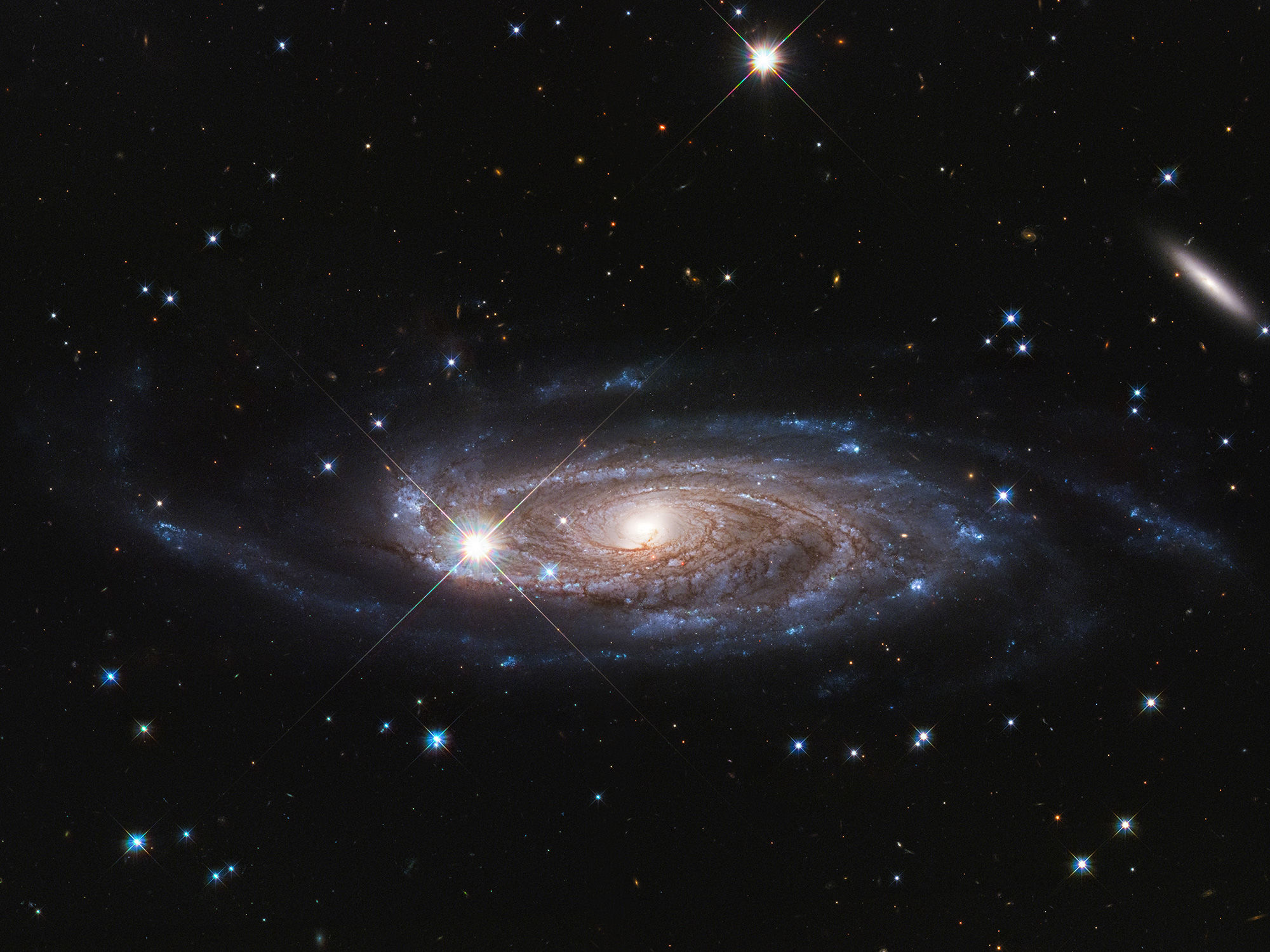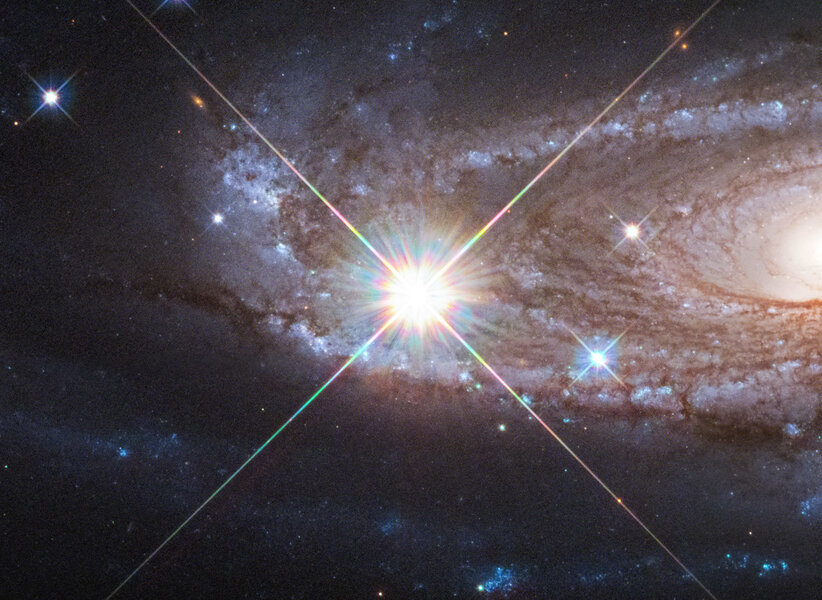Create a free profile to get unlimited access to exclusive videos, sweepstakes, and more!
Hubble's spectacular view of UGC 2885: Is this the biggest spiral galaxy in the Universe?

We live in the Milky Way galaxy, considered to be a pretty beefy example of its kind. It's a spiral galaxy, with over 200 billion stars, stretching about 150,000 (and perhaps up to 200,000) light years across its diameter.
But there are bigger galaxies out there. Malin 1, for example, looks a lot like the Milky Way, but it's 500,000 light years across (at least). UGC 1382 is another, likely also a half million light years wide. But Malin 1 is well over a billion light years away, and UGC 1382, though much closer at about 270 million light years, is actually a lightweight with far fewer stars in it than the Milky Way, despite its enormous size.
Are there any galaxies that are bigger, more massive, and relatively close to us in the Universe?
Why yes. Yes there is. Take a look at UGC 2885, a truly huge, hefty, and close by galaxy:
Holy. Flibbertigibbet. You can download a huge 10,000 x 7,500 pixel version of this, too.
That's a Hubble image of the spiral galaxy, recently released as part of the 2020 American Astronomical Society meeting held in Hawaii. The galaxy is only 230 million light years away, close by cosmic distance scales, which is why Hubble can see such amazing and lovely detail in it. And it's a monster: It may have ten times as many stars as the Milky Way, and may be a whopping 800,000 light years wide, easily four times wider than our galaxy*.
That's huge. It may be the biggest spiral galaxy known.
In general, galaxies like this grow to such enormous size by eating other galaxies. The Milky Way is surrounded by dozens of much smaller dwarf galaxies, and over time some of those pass close enough to our much larger galaxy and get torn apart by gravity. The stars, gas, and dust then fall into our galaxy and, over million of years, merge with us. It's galactic cannibalism.
Sometimes larger galaxies get et, too, in which case the damage is more extensive. It can take a long time for things to settle back down to some semblance of order.
But UGC 2885 doesn't look like that's ever happened. It's in a relatively empty volume of space, so there's not much for it to collide with. It can be hard to tell if it ate much smaller galaxies in the past, but scientists don't think it's suffered any major collisions recently, or perhaps ever. If true, then it grew to its ridiculous size slowly, simply by letting gas flow into it from intergalactic space and using it to make stars.
To try to figure this out, astronomers used Hubble to map the disk of the galaxy as well as to look for globular clusters, roughly spherical clusters of stars that orbit the galaxy. Most galaxies have a retinue of such clusters around them. If UGC 2885 grew on its own, it'll have a certain number of them, but if it grew by cannibalism, it would've stolen those clusters from its prey, and therefore have more than what's expected. The data are still being processed, so hopefully we'll know soon.
The astronomer leading the effort, Benne Holwerda, has nicknamed UGC 2885 "Rubin's Galaxy", after astronomer Vera Rubin. She is credited for discovering dark matter, the invisible material that dominates matter in our Universe but which does not emit light. Although postulated before, Rubin's work quantified dark matter by examining how stars in galaxies orbit the center; the haloes of dark matter surrounding galaxies affects their rotation due to gravity. UGC 2885 was one of many galaxies Rubin investigated, and did indeed find it to be embedded in a vast sea of dark matter.
I like this. Rubin was robbed of a Nobel prize (the rampant sexism of the prize is extremely well documented) for this discovery. She died in 2016 after an illustrious career, and Nobels are not awarded posthumously. So I'm always happy to see others honoring her memory and her work.
I'll note that in better news, she was just honored by having a very important observatory named after her: The Large Synoptic Survey Telescope (a huge 'scope that will survey the skies looking at, well, everything) is now called the NSF Vera C. Rubin Observatory. That's very cool.
Back to the galaxy, though, there's one more thing I want to point out: In that image, there is a very bright star photobombing the galaxy. The star is called HD 279085, and it's what's called a K0 subgiant star, a star that was likely once like the Sun but is running out of hydrogen in its core. It's beginning to swell up into a red giant, which means it's dying. It's about 2,500 light years from Earth, a fair distance in our galaxy, but it is a star on our galaxy, coincidentally superposed on Rubin's Galaxy. Sometimes having a star like that can spoil the view of the galaxy (and I imagine it makes things somewhat more difficult for analysis of the scientific data), but in this case it's so stunning I think I actually like it there.
Funny too, how a single star close by can distract from an immense galaxy — truly one of the most immense galaxies we know — because that galaxy is so very far away. If there's a morality tale there, feel free to ponder it for yourself.
*The press release for this image says it's 2.5 times wider than the Milky Way, so up to 500,000 light years wide, but the abstract for the observations quotes a size of 800,000 light years. Size is a hard thing to measure since galaxies don't have a hard edge; they kinda fade away with distance from the center. Either way, though, this one is a giant.
















